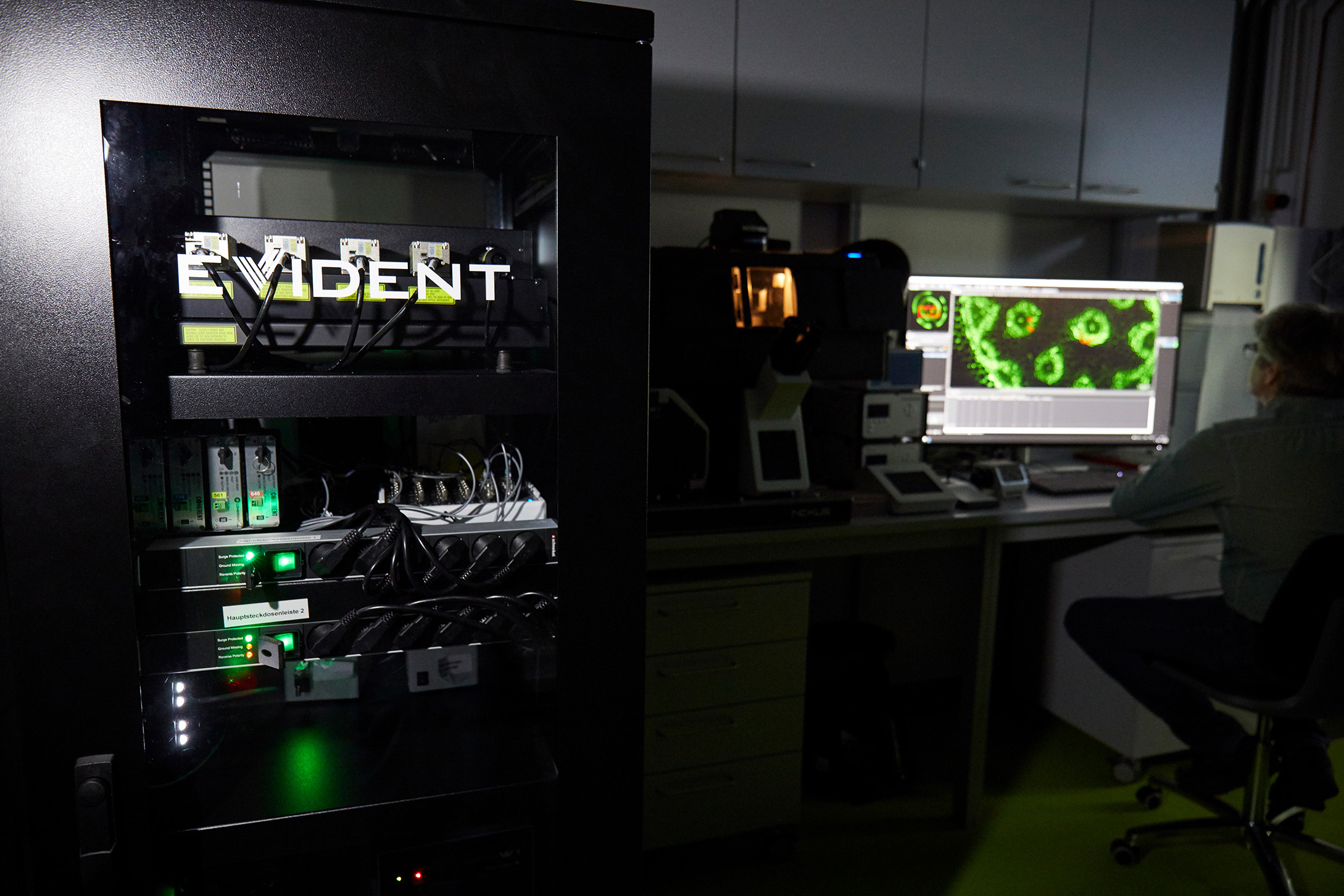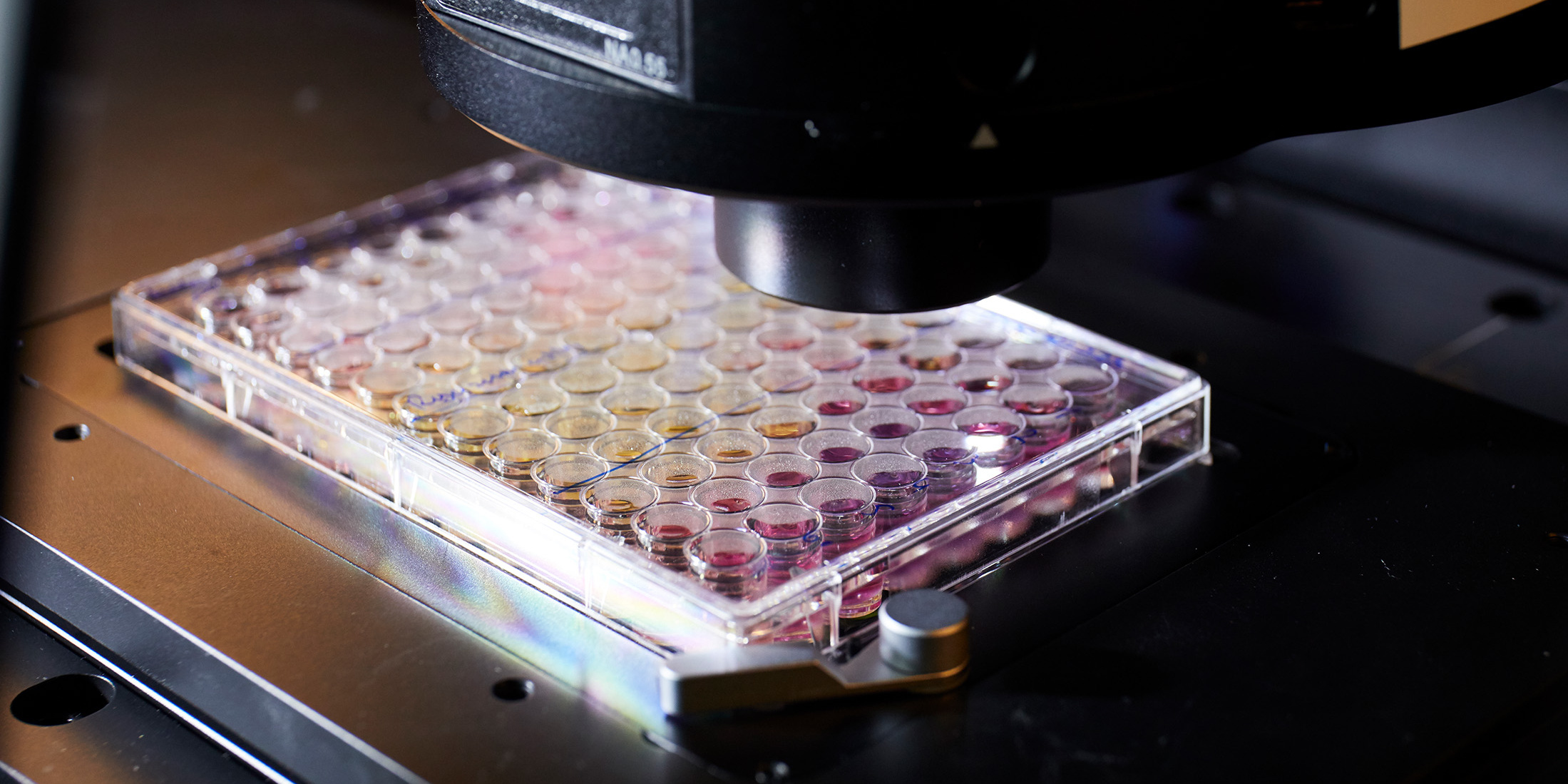Cancer, Parkinson’s disease, ageing processes

Since February, the Faculty of Chemical Engineering and Biotechnology has been able to boast a high-tech device of a special kind: the German Research Foundation (DFG) approved the application submitted by six h_da researchers and two groups from ETH Zurich for the purchase of a fluorescence microscope. The cost: around €400,000. The research groups from Darmstadt and Switzerland want to use the automatic, high-resolution microscope to explore processes in human cells that play a role in the development of diseases such as cancer and Parkinson’s or in ageing processes. In this interview with impact, the two researchers Professor Heinz Neumann and Dr Petra Neumann-Staubitz (who not only work together but are also married) cast light on the highly complex world of cell biology and microscopy.
Interview: Christina Janssen, 2.4.2025
impact: Mr Neumann, Mrs Neumann: What can this microscope do that others can’t?
Professor Heinz Neumann: The big difference is the combination of automation and the large number of samples that this microscope can process. We can study up to 384 samples at the same time.
Dr Petra Neumann-Staubitz: Apart from that, we can control the whole microscope via a software programme. That is really something special.
impact: What type of samples are you examining?
Heinz Neumann: Typically, small molecules in human tissue cells. Our ultimate goal is to find new active substances. That’s our intention with this microscope.
impact: And you are both working on this with colleagues from ETH Zurich?
Heinz Neumann: Exactly. Our project focuses on what are known as “protein condensates”. Under certain conditions, some proteins form droplets within the cellular fluid, a bit like an oil droplet in water. We want to find out more about this. Our colleagues in Zurich send us samples of such proteins, and we examine them under various conditions.
impact: Why are these protein molecules so important for your research?
Heinz Neumann: Sometimes, droplet formation is a deliberate process in a cell. But scientists assume that protein condensates also play a role in diseases such as Alzheimer’s or Parkinson’s, where “protein clumps” develop that damage the cell. First, the proteins involved form said droplets. These droplets then harden like glue. Finally, they are irreversibly entangled and attract further proteins so that larger aggregates form. And these then destroy the cells.
impact: And you want to find out under which conditions such “protein clumps” form in cells?
Heinz Neumann: Yes, and above all we want to do this systematically, that is, examine a very large range of different conditions that potentially trigger the formation of such condensates. That is why we will produce and analyse vast numbers of images. The technical term for this is “high-throughput screening”. We also want to develop a kind of quality control for this field of research. At the present time, many separate groups are working on single substances. If we systematise this, we will be able to compare results much better.
impact: What else are you investigating with the microscope?
Petra Neumann-Staubitz: The second thing we are looking at is a central stress regulator in cells, called sirtuin 1, which is known to extend lifespan. Sirtuin 1 is present in many places in the cell and interacts with many partners. It helps, for example, to repair damaged DNA or to suppress inflammation. We want to know when it interacts with what. To do this, we trigger stress in the cell, for example through insufficient nutrients, and then test before, during and after how the sirtuin reacts.
impact: So sirtuin 1 is a kind of fire brigade in the cell: if stress occurs, it comes to “extinguish” it?
Heinz Neumann: It regulates all kinds of processes in the cell. Sirtuin 1 is known above all from gerontology. A whole industry is trying to develop substances to activate sirtuin 1 because it has been shown that increased sirtuin 1 activity extends the lifespan of animals and slows down the ageing process. And now there are hopes that this will also work in humans.
impact: And does it?
Heinz Neumann: It’s not that simple, as research has shown that sirtuin 1 can also play a role in cancer development.
Petra Neumann-Staubitz: Sirtuin 1 has two facets: it can be tumour-promoting or tumour-inhibiting – depending on the tumour and the specific constellation, so blocking or activating this protein altogether doesn’t make sense. That is why we are looking at different types of cells that represent different organs in the body. If I then know that I need to inhibit sirtuin 1 in a liver cell but activate it in a heart cell, I can “build” a corresponding drug that works in exactly the same way.
Heinz Neumann: Sirtuin 1 has to be systematically “geared to” certain processes that actually control the ageing process. So I need to be able to tell the sirtuin: you have to go exactly there and switch exactly this process on or off. We want to find out through our research how that works. This might ultimately lead to a therapy. We want to lay the groundwork for this.
impact: So your research is ultimately about communication, that is, signal transmission within the cell?
Heinz Neumann: Exactly. How does the molecule know what it has to do when? How does it travel to the right place in the cell? We still don’t know. We meanwhile know that signal processing within the cell is not a two-dimensional network but a four-dimensional process: three dimensions in space plus time. That is why we have to look at individual cells in our experiments instead of populations, where each cell is doing something different at a specific time.
impact: When did you start specialising in microscopy, Mrs Neumann?
Petra Neumann-Staubitz: I earned my doctoral degree in microbiology, and my dissertation centred on pathogens that “attack” cells. But since my postdoctoral degree I’ve always, in fact, been a microscopist. I’ve already sat at so many different microscopes, but this one here really is the top of the range: the fully automatic process and the incredible possibilities offered by the software control system are tremendous.
impact: How does it feel as a researcher when you become aware of the vast complexity of all these cell biology processes for the first time?
Heinz Neumann: When you see it for the first time, it’s overwhelming. And then, once you’ve looked at it for a while, you know that you will never understand it down to the last detail.
impact articles on the Microscopy Group
impact, 13.12.2024: Just how cunning can fungi be?! (Professor Vera Göhre)
impact, 18.11.2024: Michael Becker – Professor of the Year 2024 (in German)
impact, 23.07.2024: A small step for a rover (Professor Andreas Weinmann)
impact, 18.06.2024: Nanotechnology (Professor Christina Graf and Professor Frank Schael)
impact, 10.01.2022: Hunting down proteins (Professor Franz Josef Meyer-Almes)
impact, 29.01.2024: Sustainable drug development (Professor Heinz Neumann)
impact, 11.11.2018: Microreactors (Professor Frank Schael) -in German
Contact our Editorial Team
Christina Janssen
Science Editor
University Communications
Tel.: +49.6151.533-60112
Email: christina.janssen@h-da.de
Translation: Sharon Oranski
Photography: Jens Steingässer
Links
HeLa cells:
en.wikipedia.org/wiki/HeLa
High-throughput screening:
en.wikipedia.org/wiki/High-throughput_screening






